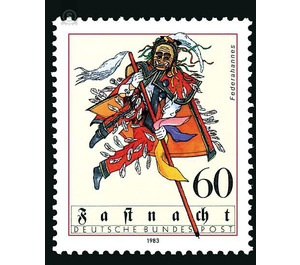Swabian-Alemannic carnival - Germany / Federal Republic of Germany 1983 - 60 Pfennig
Theme: Art & Culture
| Country | Germany / Federal Republic of Germany |
| Issue Date | 1983 |
| Face Value | 60.00 |
| Color | multi-colored white |
| Perforation | K 14 |
| Printing Type | Six-color offset printing |
| Stamp Type | Postage stamp |
| Item Type | Stamp |
| Chronological Issue Number | 1040 |
| Chronological Chapter | GER-BRD |
| SID | 298735 |
| In 59 Wishlists | |
The stamp issue continues the series of folk themes. The carnival stories are not, as many believe, pagan, but of Christian origin. Although the postulate of millennia-old customs was rebutted by the evidence that carnival customs generally did not appear until the middle of the thirteenth century, one still encounters the notion already held by mythological schools of the nineteenth century that the carnival system was fertile , Demon, ancestor and death cult, Winterdustreiben and early spring are related. Such explanations overlook the fact that carnival has been firmly embedded in the traditional calendar for centuries as liturgical time. Even popes have given their approval to the carnival: In 1207 Innocent III. "In dominica dimissionis carnium, if our carnal desire is to end," to show a game in which "the arrogance of our lust was killed." "You killed a bear, the devil, the tempter of our flesh; one killed young bulls, d. H. the arrogance of our lust; they killed a cock, the horniness of our loins. " And that happened, "so that from now on we live chaste and sober in the fight for our soul. in order to be able to receive the body of our Lord in a worthy manner at Easter. "In 1284 Martin IV recommended that the faithful" spend several days on carnival and be cheerful. " When the mendicant orders took over the city mission in the late Middle Ages, they solved the task of bringing people on Easter for Lent, by showing the alternative of a god-distant life in the short-lived transitory realms and by requesting to be willing to do so with such a life to break through the show of a perverted kingdom of God to show the futility of an exclusive this side orientation. The carnivores of carnival and Carnival appear as a self-contained system. To him belong consistent figures and action moves. Typical roles include the seducers of the world (devils, witches, giants, and antichrists), the rulers of the world (fool-kings and princes with retinue), and the citizens of the world (fools, sinners, heathens, and adversaries). Stereotypical acts include setting up the fools' empires, taking over the foolishness, practicing foolishness and eliminating the fool's rights, the noise, the slap, the show trials, and various court and tournament games. In the world of carnival fools, the desired (hierarchical) order is turned into its opposite. Although the understanding of the traditional Christian worldview has diminished since secularization, mythological interpretations and National Socialist propaganda have obstructed access to it. But their function of setting the stage for Lent still lives up to the carnival and carnival customs, despite all commercialization, at least when the whole haunting is over on Ash Wednesday. The "Federahannes" is one of the Rottweiler carnival figures known far beyond the borders of the Swabian-Alemannic region. His robe is covered with feathers all over. He carries with him a pole about the size of a man, where he moves elegantly through the streets at the "Fool's Jump." At the upper end of the wooden pole, a perfumed calf tail is attached, with which he gently brushes off the spectators of the fool's jump. The "Federahannes" is not a witch form. With the dangerously looking tusks sticking out of the corners of his mouth and the rolled-up chins, he reminds one of the devil masks of the alpine carnival tradition; however, there are no demonstrable direct references. (Extract from texts by Prof. Dr. Dietz-Rüdiger Moser, University of Freiburg i. Br., Dept. of Folklore of the German Seminar and Dr. Werner Mezger, Rottweil)


